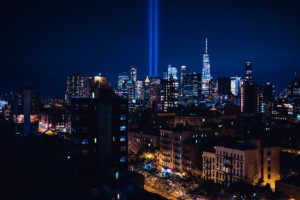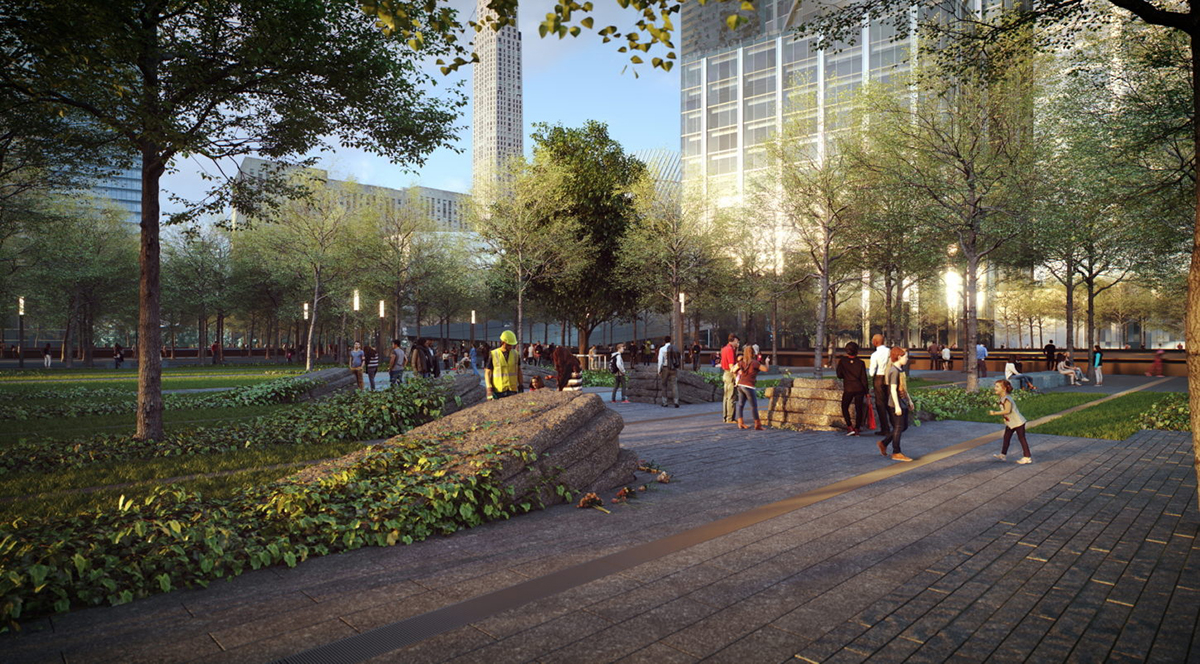In the early aftermath of September 11, 2001, New York City showed incredible resilience as people banded together to support those who were affected by the tragedy. The fateful day’s horrific events took thousands of lives with the collapse of the two tallest towers in the United States, leaving rubble and wreckage at Ground Zero. In an effort to reclaim the site as a powerful and beautiful place to work, gather, and reflect, an unprecedented wave of downtown development began 17 years ago. We’ve all watched the city build—from scratch—a new complex that doesn’t replace history, but strengthens it.
The new World Trade Center stands today as a place of remembrance and as an architectural marvel of the early 21st century—one that was built at an extraordinarily aggressive schedule and isn’t done yet. With a master plan designed by Studio Libeskind, the 16-acre site includes a handful of office towers, cultural facilities, commercial spaces, and parkland all conceived by world-class architects working within the confines of a nationally significant property.
One of the most-anticipated upcoming projects, a performing arts center by Brooklyn-based studio REX, is now under construction with an estimated completion date between 2020 and 2022. In honor of the anniversary of 9/11 and what’s to come for the booming site, here’s a look back at the history of the structures that now populate the grounds and the few that remain to be built.
7 World Trade Center
Designed by SOM’s David Childs, this 52-story tower was the first completed building to open on the site in 2006. The award-winning structure was also the first office building in New York to be LEED Gold–certified. Its reflective skin features floor-to-ceiling glass panels that reflect the tone of the sky, allowing its westward-facing facade to seemingly disappear from sight. At night, LED installations line the base of the tower with text art from artist Jenny Holzer.
4 World Trade Center
Finished in 2013, this Fumihiko Maki–designed office tower stands 72 stories tall with 140,000 square feet of retail on its first five floors. Home to Eataly, H&M, and Banana Republic, it’s part of the Westfield World Trade Center shopping mall, which extends into the adjacent transit hub designed by Santiago Calatrava. Maki and Associates’ minimalist design includes a glazed exterior with colored silver glass that achieves a metallic quality as the light changes throughout the day. The southwest and northeast corners are also drastically indented to provide views for the office space inside.
National September 11 Memorial and Museum
The 9/11 Memorial is the heart of the area’s redevelopment. Conceived by Michael Arad and Peter Walker in 2003, the memorial design features two recessed pools set within the footprints of the original Twin Towers. These large black voids receive continuous streams of water, with the names of victims etched in the black stone’s edge.
The National September 11 Memorial Museum, created by Davis Brody Bond in collaboration with Arad and Walker, houses the physical building blocks of the former WTC campus as well as found artifacts, written articles, and gathered anecdotes from the day of the attacks. Completed in 2014, the 110,000-square-foot museum features an above-ground glass pavilion designed by Snøhetta that welcomes visitors into a light-filled space before descending 70 feet below into the cavernous Foundation Hall, built around one of the original towers’ retaining walls.
One World Trade Center
Designed by SOM’s David Childs, One WTC rises 1,776 feet to the top of the New York City skyline. The 104-story structure opened in spring 2014 with its first tenant, Condé Nast, moving in later that year. The iconic building’s form is shaped by eight isosceles triangles that interlock in such a way that the floorplans, square at both top and bottom, are octagonal in the middle. The base of the structure features 2,000 pieces of prismatic glass that refract the changing light throughout the day.
Oculus
The $4-billion architectural object housing the revamped World Trade Center Transportation Hub features the winged design of Santiago Calatrava. Designed to resemble a bird in flight, the striking structure opened in May 2016 after years of construction delays and budget overruns. Now, it’s the site of the aforementioned Westfield Mall, situated inside a pristinely-white, soaring interior with a ribbed roof. Each year on September 11, the overhead window panels fully retract to reveal an open skylight that stretches the length of the building. The “Way of Light” annually shines through at 10:28 a.m. when the second tower fell.
Liberty Park
Designed by AECOM’s landscape studio, the 64,000-square-foot Liberty Park is set atop the World Trade Center’s vehicle screening center, providing unmatched views of the memorial and surrounding office complex. It opened in 2016 to rave reviews as the only public part of the site that’s easily walkable, providing a simple pedestrian pathway from east to west. The one-acre open space features ample seating, 19 planters, and a 300-foot-long green wall. Also situated within the park is the Calatrava-designed St. Nicholas Greek Orthodox Church, currently under construction but stalled due to fundraising issues.
3 World Trade Center
Richard Rogers’s design for 3 WTC was completed earlier this summer as the 1,079-foot tower welcomed its first tenants in June. Designed with a stepped profile, the tower’s corners are accentuated by stainless steel load-sharing trusses that allow for column-free interiors and unobstructed panoramic views of the city. The building also features a 5-story podium and three large-scale terraces.
2 World Trade Center
Originally planned with a design by Norman Foster, 2 WTC is the last remaining tower to be built on the campus, now featuring a proposal by Bjarke Ingels Group. The 90-story tower will be made up of seven cuboid volumes stacked atop one another, allowing for green terraces within each setback. Currently, colorful murals wrap around the construction site of 2 WTC as well as the bottom of 3 WTC, showcasing the breadth of new creative talent that’s moved to the Financial District since the new campus opened.
Ronald O. Perelman Performing Arts Center
Having broken ground just months ago on the northeast side of the WTC campus, the new REX-designed performing arts center will be housed within a translucent, marble-clad box. Through its thin exterior walls, daylight will seamlessly filter into the 90,000-square-foot structure while at night, the white-veined cuboid will serve as a beacon for the site. The building will be divided into three levels with performances spaces and back-of-house support areas. REX unveiled their design for the center in 2016 and construction is expected to be finished within the next two to four years.











